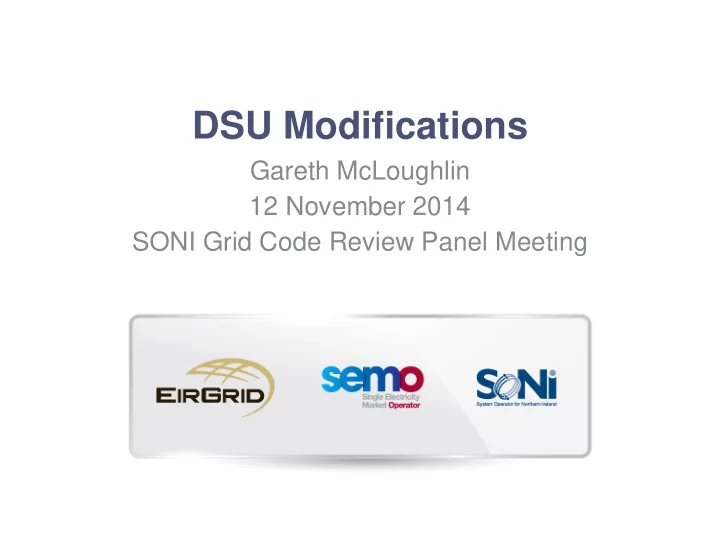

DSU Modifications Gareth McLoughlin 12 November 2014 SONI Grid Code Review Panel Meeting
5 Modifications 1. Background 2. Frequency Requirements for Generation operated as part of a DSU 3. Application Form Data Requirements 4. Notice Time 5. Signal Requirements 6. Performance Monitoring of DSU Dispatch Instructions 7. Next Steps
Background • 4 week consultation from 10 th May to 7 th Jun 2013 on original modifications with respect to DSU requirements. • Details of the consultation available on SONI website: – Consultations: http://www.soni.ltd.uk/Operations/GridCodes/documentation/consultations/ – Modifications: http://www.soni.ltd.uk/Operations/GridCodes/documentation/modifications/ • Comments in 2 responses received were addressed and a Report issued to URegNI on 10 th July 2013 seeking approval of changes. • URegNI have indicated that they will not approve the original Modification, but will await a Report on the further changes proposed for DSUs.
Frequency Requirements • Each Demand Side Unit ( or on-site generation operated as a continuous Synchronous Generating Unit that forms part of a Demand Side Unit) shall, as a minimum, have the following capabilities: • (h) maintain Demand Side Unit MW Response at NI System Frequencies in the range 49.5Hz to 52Hz; • (i) maintain Demand Side Unit MW Response at NI System Frequencies within the range 48Hz to 49.5Hz for a duration of 1 hour; • (j) maintain Demand Side Unit MW Response at NI System Frequencies within the range 47.0Hz to 48Hz for a duration of 5 minutes; and • (k) maintain Demand Side Unit MW Response for a rate of change of NI System Frequency up to and including 1.0 Hz per second as measured over a rolling 500 milliseconds period. • On-site Generation operating in DSU Short-term Synchronous Operating Mode that forms part of a Demand Side Unit , shall, as a minimum, have the following capabilities: • (p) operate continuously at normal rated output at NI System Frequencies in the range 49.5Hz to 52Hz;
Frequency Requirements EirGrid Requirement Period (Hz) Synchronised 49.5 – 50.5 Continuous 47.5 – 52.0 60 Mins 47.0 – 47.5 20 sec Short Term 49.5 – 50.5 Continuous SONI Requirement Period (Hz) Synchronised 49.5 – 52.0 Continuous 48.0 – 49.5 60 Mins 47.0 – 48.0 5 Mins Short Term 49.5 – 52.0 Continuous
Application Form Data Requirements • Aligning application form data requirements on an all-island basis, as much as possible. • EirGrid have included ‘Modes of Operation’ of Individual Demand Sites at request of ESB. SONI have included a new definition ‘ DSU Short-term Synchronous Operating Mode’ in the glossary to provide clarity on the frequency requirements for generators that form part of a DSU. • TSO-DSO engagement on-going regarding application process. DSOs have differing views on this. TSO relaxed as who provides the information as long as it is available.
Notice Time DI Effective Time DI Effective Time
Signal Requirements • total aggregated Demand Side Unit MW Response from Generation operating as a continuous Synchronous Generating Unit; • aggregated Demand Side Unit MW Response from Generation operating as a continuous Synchronous Generating Unit per Bulk Supply Point ; • total aggregated Demand Side Unit MW Response from avoided Demand consumption and Generation operating in DSU Short-term Synchronous Operating Mode ; • aggregated Demand Side Unit MW Response from avoided Demand consumption and Generation operated in DSU Short-term Synchronous Operating Mode per Bulk Supply Point ; • Remaining Demand Side Unit MW Capacity Availability ;
Signal Requirements • Demand Side Unit MW Response from each Individual Demand Site with a Demand Side Unit MW Capacity of greater than or equal to 5 MW ; • MW Output from Generation Units with a capacity greater than or equal to 5 MW ; • Mvar output from Generation Units with a capacity greater than or equal to 5 MW at Individual Demand Sites with a Maximum Export Capacity specified in the Connection Agreement or DNO Connection Agreement as applicable, as required by the TSO; • Aggregate MW Output from Generation Units with a combined Capacity of greater than or equal to 5 MW on an Individual Demand Site , as required by the TSO; and • Demand Side Unit MW Response from each Individual Demand Site that comprises the Demand Side Unit , as required by the TSO .
Performance Monitoring of DSU DIs • Current Method – DSU predicts D-1 aggregated demand of all Individual Demand Sites that comprise the DSU for each half-hour trading period of the trading day – Must be accurate to within 5% when not dispatched – Used as baseline when dispatched • New Method – Baseline calculated based on correlation with historical data – Worked example available on EirGrid Website: • http://www.eirgrid.com/media/DSU_PM_of_DI_Worked_Example_DRAFT- Multiple_Sheets_No_Formulas.xlsb • http://www.eirgrid.com/media/DSU_PM_of_DI_Worked_Example_DRAFT- Single_Sheet_Formulas.xlsb
Next Steps • 4 week Consultation on NI Grid Code wording issued on 17 th October 2014. • As previous modifications have not been approved, the consultation document covered both sets of modifications. • Any comments that may be received are expected to be of a minor nature as working group has addressed most issues already. • Report will then be forwarded to URegNI seeking approval
Recommend
More recommend